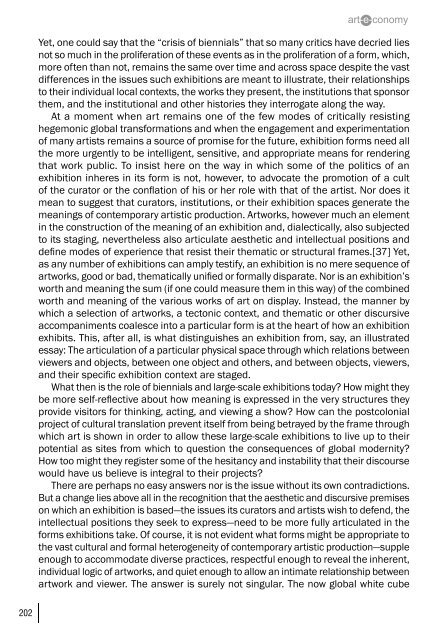art-e-conomy _ reader - marko stamenkovic
art-e-conomy _ reader - marko stamenkovic
art-e-conomy _ reader - marko stamenkovic
You also want an ePaper? Increase the reach of your titles
YUMPU automatically turns print PDFs into web optimized ePapers that Google loves.
202<br />
Yet, one could say that the “crisis of biennials” that so many critics have decried lies<br />
not so much in the proliferation of these events as in the proliferation of a form, which,<br />
more often than not, remains the same over time and across space despite the vast<br />
differences in the issues such exhibitions are meant to illustrate, their relationships<br />
to their individual local contexts, the works they present, the institutions that sponsor<br />
them, and the institutional and other histories they interrogate along the way.<br />
At a moment when <strong>art</strong> remains one of the few modes of critically resisting<br />
hegemonic global transformations and when the engagement and experimentation<br />
of many <strong>art</strong>ists remains a source of promise for the future, exhibition forms need all<br />
the more urgently to be intelligent, sensitive, and appropriate means for rendering<br />
that work public. To insist here on the way in which some of the politics of an<br />
exhibition inheres in its form is not, however, to advocate the promotion of a cult<br />
of the curator or the conflation of his or her role with that of the <strong>art</strong>ist. Nor does it<br />
mean to suggest that curators, institutions, or their exhibition spaces generate the<br />
meanings of contemporary <strong>art</strong>istic production. Artworks, however much an element<br />
in the construction of the meaning of an exhibition and, dialectically, also subjected<br />
to its staging, nevertheless also <strong>art</strong>iculate aesthetic and intellectual positions and<br />
define modes of experience that resist their thematic or structural frames.[37] Yet,<br />
as any number of exhibitions can amply testify, an exhibition is no mere sequence of<br />
<strong>art</strong>works, good or bad, thematically unified or formally disparate. Nor is an exhibition’s<br />
worth and meaning the sum (if one could measure them in this way) of the combined<br />
worth and meaning of the various works of <strong>art</strong> on display. Instead, the manner by<br />
which a selection of <strong>art</strong>works, a tectonic context, and thematic or other discursive<br />
accompaniments coalesce into a p<strong>art</strong>icular form is at the he<strong>art</strong> of how an exhibition<br />
exhibits. This, after all, is what distinguishes an exhibition from, say, an illustrated<br />
essay: The <strong>art</strong>iculation of a p<strong>art</strong>icular physical space through which relations between<br />
viewers and objects, between one object and others, and between objects, viewers,<br />
and their specific exhibition context are staged.<br />
What then is the role of biennials and large-scale exhibitions today? How might they<br />
be more self-reflective about how meaning is expressed in the very structures they<br />
provide visitors for thinking, acting, and viewing a show? How can the postcolonial<br />
project of cultural translation prevent itself from being betrayed by the frame through<br />
which <strong>art</strong> is shown in order to allow these large-scale exhibitions to live up to their<br />
potential as sites from which to question the consequences of global modernity?<br />
How too might they register some of the hesitancy and instability that their discourse<br />
would have us believe is integral to their projects?<br />
There are perhaps no easy answers nor is the issue without its own contradictions.<br />
But a change lies above all in the recognition that the aesthetic and discursive premises<br />
on which an exhibition is based—the issues its curators and <strong>art</strong>ists wish to defend, the<br />
intellectual positions they seek to express—need to be more fully <strong>art</strong>iculated in the<br />
forms exhibitions take. Of course, it is not evident what forms might be appropriate to<br />
the vast cultural and formal heterogeneity of contemporary <strong>art</strong>istic production—supple<br />
enough to accommodate diverse practices, respectful enough to reveal the inherent,<br />
individual logic of <strong>art</strong>works, and quiet enough to allow an intimate relationship between<br />
<strong>art</strong>work and viewer. The answer is surely not singular. The now global white cube


